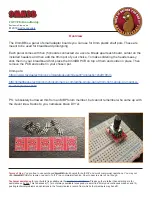
ScreenMaster RVG200
Paperless recorder
7 Configuration
OI/RVG200-EN
93
Example
– for an electrical input range of 4.0 to 20.0mA, representing a
pressure range of 50 to 250 bar, set the
Low
value to
50.0
and the
High
value to
250.0
.
Note.
Select any of the engineering units pre-programmed into the
recorder or select
Custom
and enter user-defined units (6
characters maximum). Refer to Appendix D, Table D.1, page 171
for a description of the pre-defined engineering units.
The recorder can be configured to calculate the totalizer count rate
automatically by ensuring that the engineering range unit of
measurement selected for the channel to which the totalizer is
assigned is a volumetric unit (quantity per unit of time, for example
gallons per hour) – see page 103. If the recorder holds the
relationship data between the selected measurement units and
totalizer units, the count rate parameter is calculated and displayed
automatically.
Tag
*
Enter the tag name to be displayed in the Chart-, Bargraph-, and
Indicator-views and used to identify the channel in archive files
(20 characters maximum).
Refer to Appendix F, page 180 for further information regarding character
use in tags.
Filter time constant
Set the time period over which the process variable is to be filtered prior to
being sampled (0 to 60 seconds).
Fault detect level
Set a tolerance level (between 0 and 100% of the engineering range) to
allow for deviation of the input signal above or below the input span
before an input failure is detected.
Example
– setting the fault detection level to 10% on an input range of 50
to 250 bar causes an analog input failure fault to be detected below
30 bar and above 270 bar.
Broken sensor direction
In the event of an input failure, recorder channels can be set to drive
upscale, downscale or in the direction of failure.
None
Upscale
Downscale
–
–
–
channel value driven in direction of failure.
channel value driven beyond full scale.
channel value driven below zero
*
If this parameter is changed, internally-recorded data files are recreated and unarchived data is lost.
















































